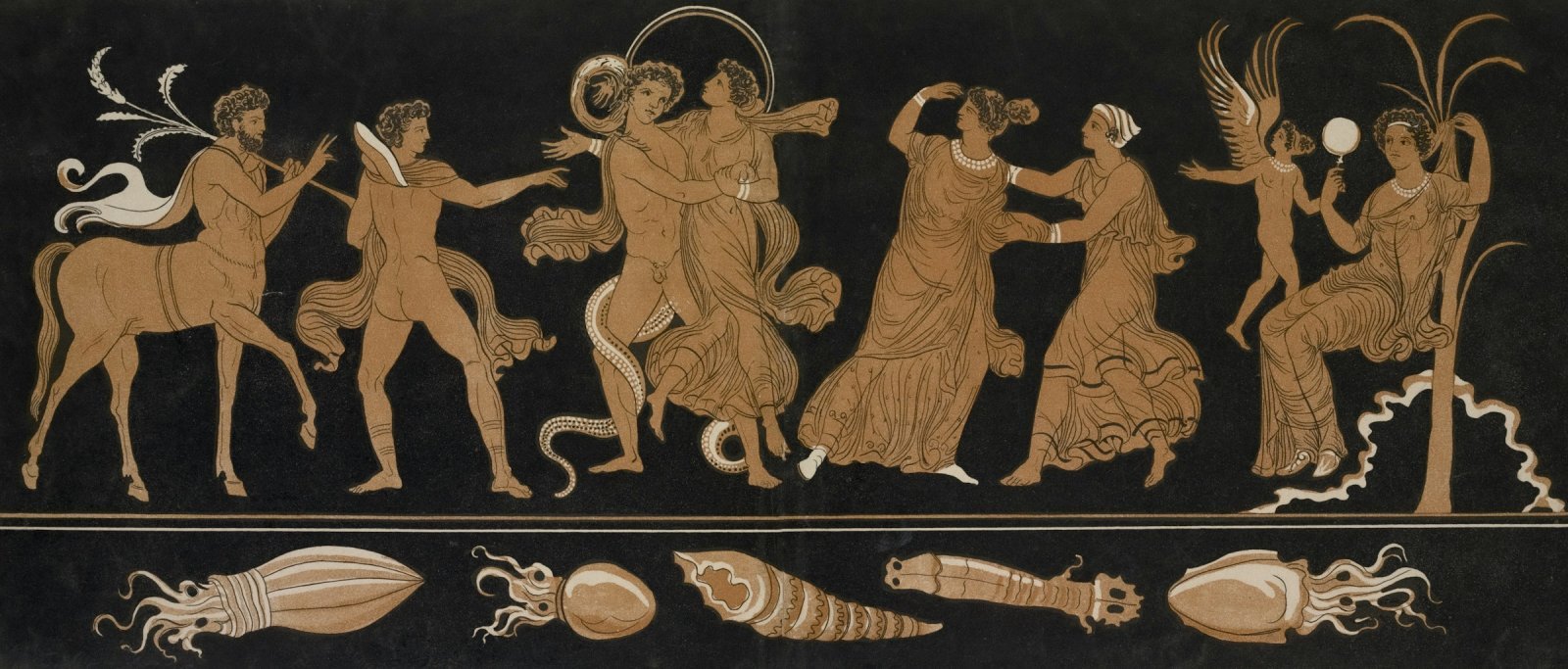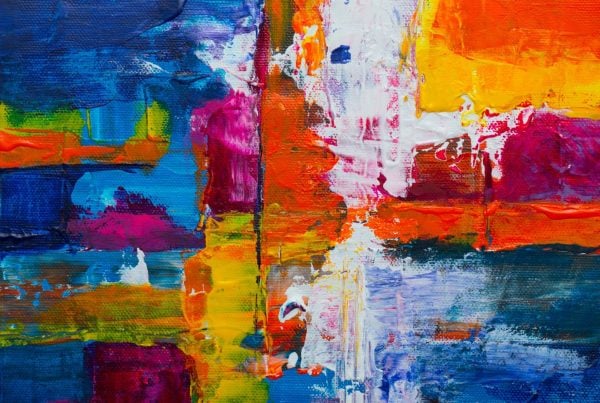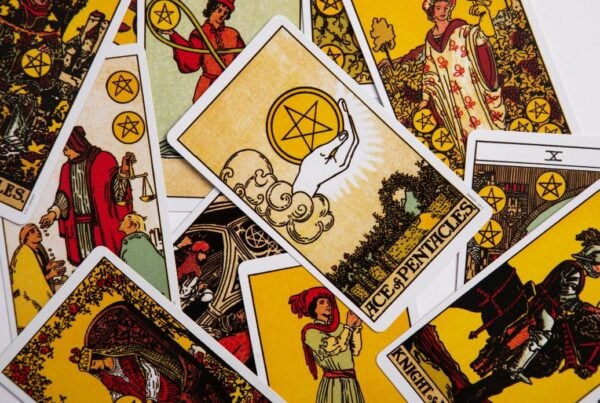Throughout history, mythical creatures have served as both symbols and storytellers, capturing human imagination across cultures and eras. From griffins in ancient manuscripts to gargoyles on Gothic cathedrals, these fantastical beings have influenced art, design, and societal beliefs. This article delves into their enduring significance, exploring how they reflect humanity’s fears, aspirations, and creative expression while bridging historical traditions with contemporary interpretations.
Table of Contents
Entities in Mythology and Their Significance
Deities and Their Realms
Mythical creatures have captured human imagination across cultures and centuries, often serving as bridges between the natural and supernatural. These beings, deeply intertwined with folklore and religion, reflect the values, fears, and aspirations of the societies that created them. From deities’ guardians to symbols of moral lessons, mythical creatures reveal much about how humans interpret their world. By exploring mythology from around the globe, we can uncover the shared human desire to explain the unknown, as well as the diverse ways different cultures have expressed their beliefs through fantastical stories and beings.
Mythological Creatures from Around the World
Greek Mythology: Guardians and Monsters of Power
Greek mythology is renowned for its diverse array of mythical creatures, each steeped in complex narratives of power, danger, and transformation.
- The Minotaur: A half-man, half-bull creature that resided in the labyrinth of Crete. It symbolised the consequences of unchecked ambition and human ingenuity in overcoming challenges.
- The Hydra: A multi-headed serpent defeated by Heracles as one of his Twelve Labours. The creature’s regenerative ability (growing two heads for each one cut) symbolises resilience and the persistence of evil.
- Pegasus: A winged horse born from the blood of Medusa, representing poetic inspiration and divine favour. It became a symbol of freedom and artistic imagination, frequently depicted in ancient art and literature.
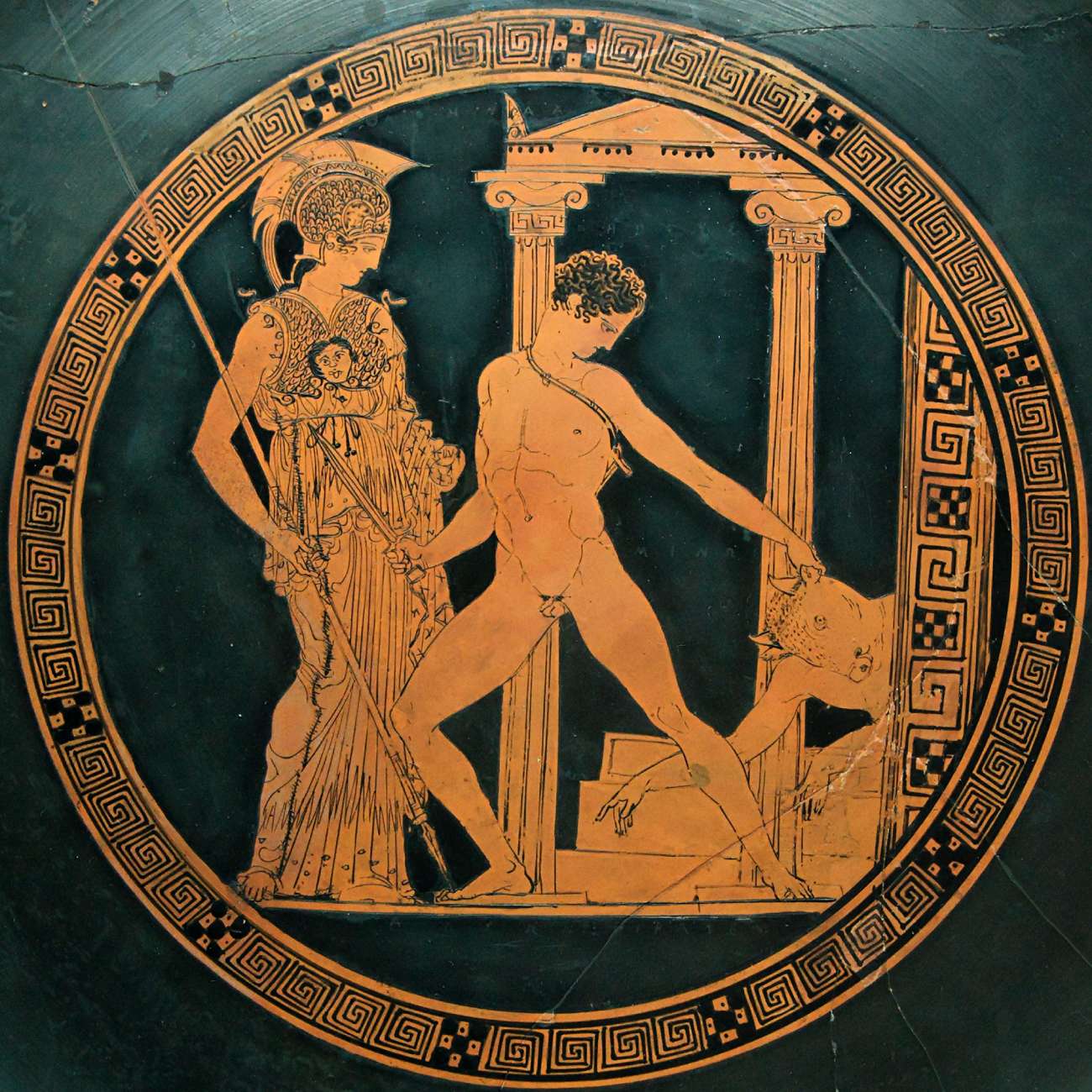
Tondo showing the victory of Theseus over the Minotaur in the presence of Athena from c. 435 BC – Wikipedia
Japanese Mythology: Spiritual Creatures and Guardians
Japanese folklore offers a rich tapestry of creatures that embody nature’s power and moral lessons.
- Kitsune (Fox Spirit): Known for their intelligence and magical shape-shifting abilities, kitsune are both protectors and tricksters. They are often associated with Inari, the Shinto deity of rice and prosperity. Tales frequently depict them teaching lessons about greed or deception.
- Dragons: Symbolising water, wisdom, and strength, Japanese dragons are often depicted as benevolent creatures. They are guardians of rivers and seas, reflecting the country’s connection to water-based resources.
- Oni (Demonic Beings): These horned ogres embody chaos and punishment. Oni appear in traditional noh theatre and are depicted in bold, vibrant art to convey lessons about morality and justice.
Irish Mythology: Haunting and Transformative Beings
Irish mythology is rich in creatures that connect the natural and supernatural worlds.
- The Banshee: A spectral woman whose mournful wail foretells death. The banshee embodies themes of fate and mortality, reflecting Ireland’s deep respect for Celtic Deities the unknown and the afterlife.
- The Púca: A mischievous, shape-shifting entity that brings fortune or misfortune. It can appear as a horse, goat, or human-like figure, symbolising the unpredictable forces of nature. Stories of the púca reflect the Irish oral tradition and the balance between chaos and harmony.
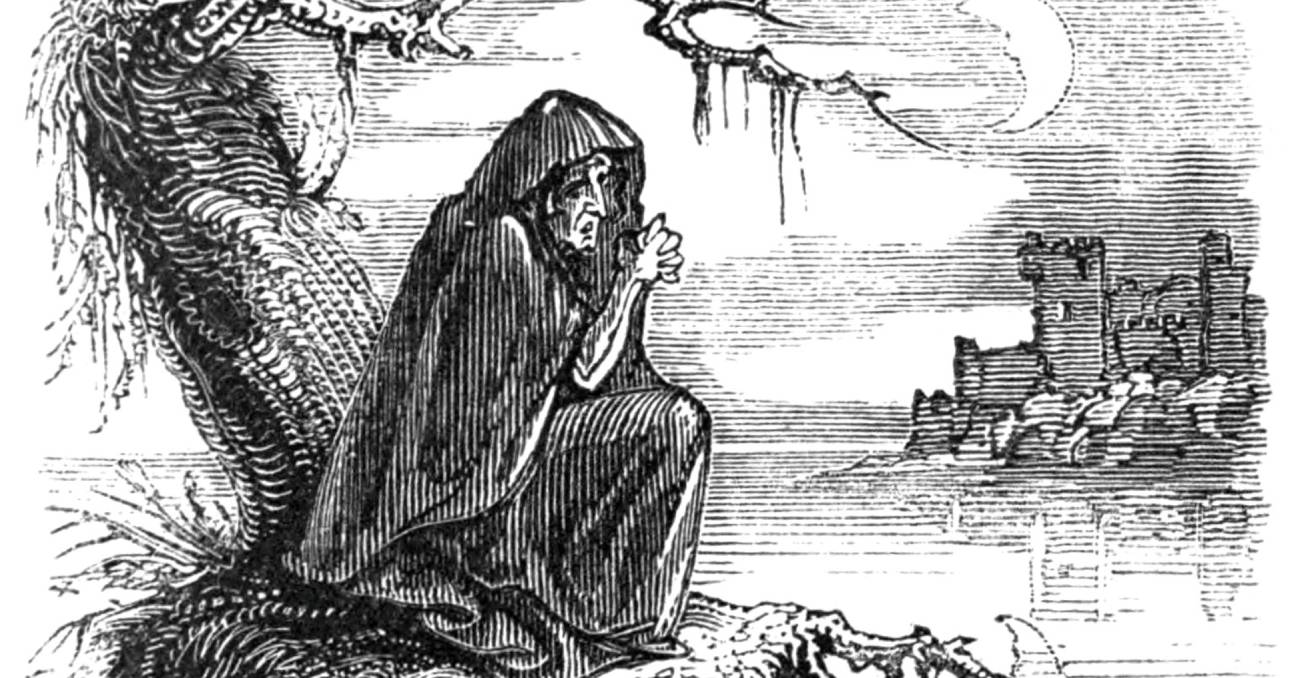
The Banshee – moriartys.ie
African Mythology: Forces of Nature and Balance
African folklore reveres creatures that embody the natural world’s power and unpredictability.
- Inkanyamba: A Zulu serpent associated with storms and rainfall. Revered as a guardian of natural balance, its presence underscores respect for nature’s destructive and life-giving forces.
- Anansi (Spider): Though not a monster, Anansi is a trickster figure central to African storytelling, symbolising wisdom and cunning.
Native American Lore: Spiritual Symbols of Harmony
Native American myths feature beings that bridge the spiritual and natural realms, emphasising harmony with the environment.
- Thunderbirds: Majestic beings controlling the skies, often depicted in totem poles. Thunderbirds represent strength, divine intervention, and environmental harmony, reinforcing the reciprocal relationship between humanity and nature.
- Coyote: Another key figure in Native American lore, the coyote is both a trickster and a teacher, highlighting dualities of wisdom and folly.
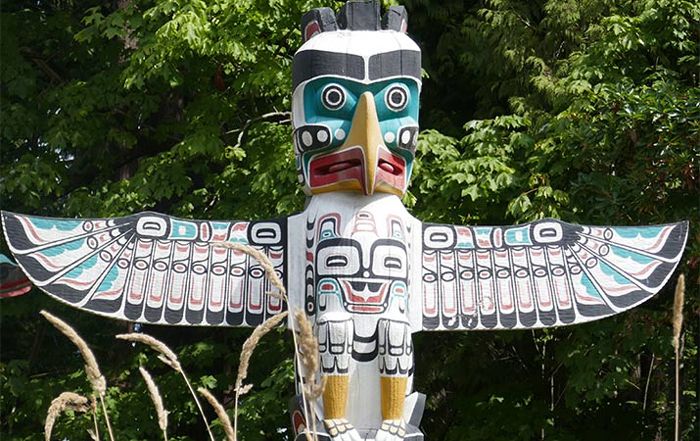
Thunder Bird Totem Pole – legendsofamerica.com
While we have briefly explored a selection of key mythologies and their mythical creatures, it’s important to recognise that the world is teeming with a vast array of such traditions. Each of these diverse cultures reflects unique values, offering timeless lessons through their myriad mythical creatures and enchanting stories.
Symbolism and Representation
Mythical Creatures as Cultural Icons
Cultural identities are often shaped by mythical figures, transcending time and geography to become emblematic of shared human experiences. These figures serve as reflections of the cultural values and aspirations of their societies:
- Chinese Dragon: Symbolises strength, prosperity, and imperial power. Frequently depicted in art forms ranging from ancient pottery to modern festivals, the Chinese dragon represents the unity of heaven and earth, embodying cosmic balance and authority.
- Unicorn: Deeply rooted in European folklore, the unicorn has become synonymous with purity and magic. Appearing in medieval tapestries and heraldic designs, it symbolises unattainable ideals and spiritual perfection.
- Naga (India): Revered as protectors of water and fertility, naga are often depicted in temple sculptures and sacred art. They symbolise the cyclical nature of life and the interconnectedness of existence.
- Anansi Spider (Africa): A trickster figure central to African storytelling, Anansi represents wisdom, ingenuity, and the ability to outsmart opponents. He remains a symbol of resilience and adaptability in African and diasporic cultures.
These creatures act as cultural ambassadors, connecting us to our ancestral past while evolving to suit contemporary narratives. Their enduring relevance is evident in modern media, fashion, and literature, where they continue to shape collective identity and inspire creativity.
Good vs Evil: An Artistic Exploration
Mythical creatures frequently embody dualistic themes, serving as metaphors for the eternal struggle between light and darkness. These themes are explored in both architectural and artistic traditions:
- Gargoyles: Found in Gothic cathedrals, these grotesque figures ward off evil spirits while doubling as functional water spouts. Their eerie features remind us of the unseen forces at play in the human world.
- Dragons: Their symbolic meaning shifts across cultures. In Europe, dragons often represent chaos and malevolence, depicted as foes in heroic tales of conquest. In contrast, Asian dragons are revered as wise and benevolent guardians, associated with water and prosperity.
- Angels and Demons: Medieval stained glass windows frequently depict angels combating demons, illustrating spiritual warfare and moral lessons.
Artistic depictions of mythical creatures delve deeply into moral and philosophical dilemmas. Baroque paintings, with their dramatic contrasts of light and shadow, use these beings as allegories for human virtues and vices. Such works do more than capture the eye; they engage viewers as participants in a timeless dialogue about morality and the human condition
Mapping Myths and Monsters
Old world maps have long fascinated historians and art enthusiasts alike, serving as windows into the imaginations of early cartographers. Famous examples such as the Piri Reis map, a 16th-century Ottoman chart, showcase remarkable geographic knowledge alongside intricate details of uncharted territories. These maps often blended science with creativity, portraying mythical creatures and speculative lands to captivate their audiences. However, among these masterpieces, the Montes Planisphere stands out for its extraordinary depictions of mythological creatures and otherworldly realms.
The Montes 10ft Planisphere

Largest Early World Map – Monte’s 10 ft. Planisphere of 1587
The Montes Planisphere, a monumental map created in 1587 by Urbano Monte, is a masterpiece of cartographic art and one of the most remarkable historical maps of its time. Assembled from 60 hand-drawn sheets, this 10-foot square planisphere is the largest known early map of the world, showcasing Monte’s extraordinary dedication to detail and artistry. Unlike other famous maps, such as the Piri Reis map, which focused primarily on geographic accuracy, the Montes Planisphere stands out for its rich depictions of mythological creatures and speculative lands. Featuring illustrations of sea serpents, dragons, and hybrid beasts, the map transforms the blank spaces of the unknown into a vivid canvas of imagination and storytelling. This unique combination of scientific innovation, artistic flourish, and mythological elements captures an era where exploration and creativity were inseparably intertwined.
Illustrations and Depictions
The image from Monte’s 10-foot Planisphere vividly illustrates how mythical creatures like sea monsters, unicorns, and hybrid beasts captivated viewers with their intricate designs and ominous presence. These illustrations were far from mere decoration; they served as warnings to travellers, marking the boundaries of the known world and sparking the imagination of those who dared to venture beyond. Each creature depicted, such as the leviathan or fantastical dragons, carried layers of symbolic meaning, blending cautionary tales with cultural myths.
For example, in the below section of the map, a unicorn is prominently featured, symbolising mystery and rarity in uncharted lands. Nearby, a lion-headed beast and other hybrid creatures signify regions of danger or mystical allure. These illustrations, placed amidst real geographical details, merge myth and reality, creating an imaginative landscape that invites both curiosity and trepidation.
Accompanying inscriptions often heightened the impact of these creatures, describing their ferocity and adding an air of authenticity to their mythical nature. Through such vivid depictions, cartographers like Monte transformed their maps into more than navigational tools, they became works of art and storytelling, evoking wonder, caution, and an enduring fascination with the unknown.
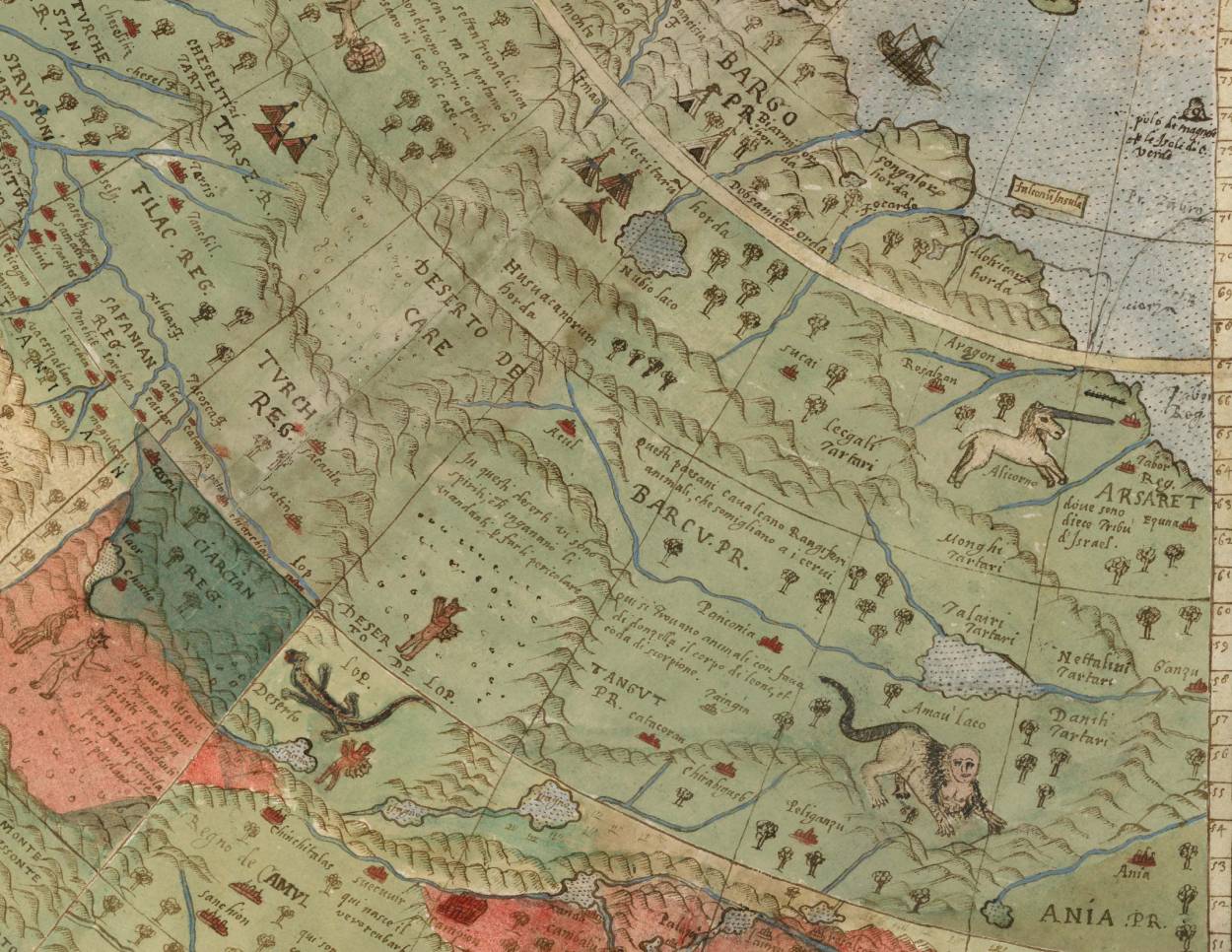
Details of Tavola Seconda, Tavola Ottava, and Tavola Setima (Northern Siberia, Central Asia)
Cultural Significance
Cartographers used mythical creatures to symbolise uncharted territories, offering both cautionary tales and a sense of wonder. These beasts reflected the human need to make sense of the unknown, blending scientific observation with artistic interpretation. Maps like the Montes Planisphere serve as historical artefacts, capturing the intersection of knowledge, myth, and creativity. By combining geographic precision with artistic flourishes, such maps transformed exploration into an imaginative journey for their viewers.
Interestingly, some interpret maps like the Montes Planisphere (1587) as precursors to modern debates, such as the “flat earth map” concept with many searching for “flat earth map 1587” and finding this map. This historical map, rich in artistry and detail, fuels contemporary intrigue as it blends accurate geography with speculative interpretations. Its legacy underscores how maps can be both practical tools and mirrors of cultural imagination.
The Blemmyes: Mythical Creatures of History and Maps
The Blemmyes are legendary figures often described in ancient texts and depicted on medieval maps. Said to be a headless people with their faces located on their chests, the Blemmyes were first mentioned by ancient Greek and Roman writers such as Herodotus and Pliny the Elder. These descriptions placed them in regions south of Egypt and Nubia, adding a mythical allure to the geography of Africa.
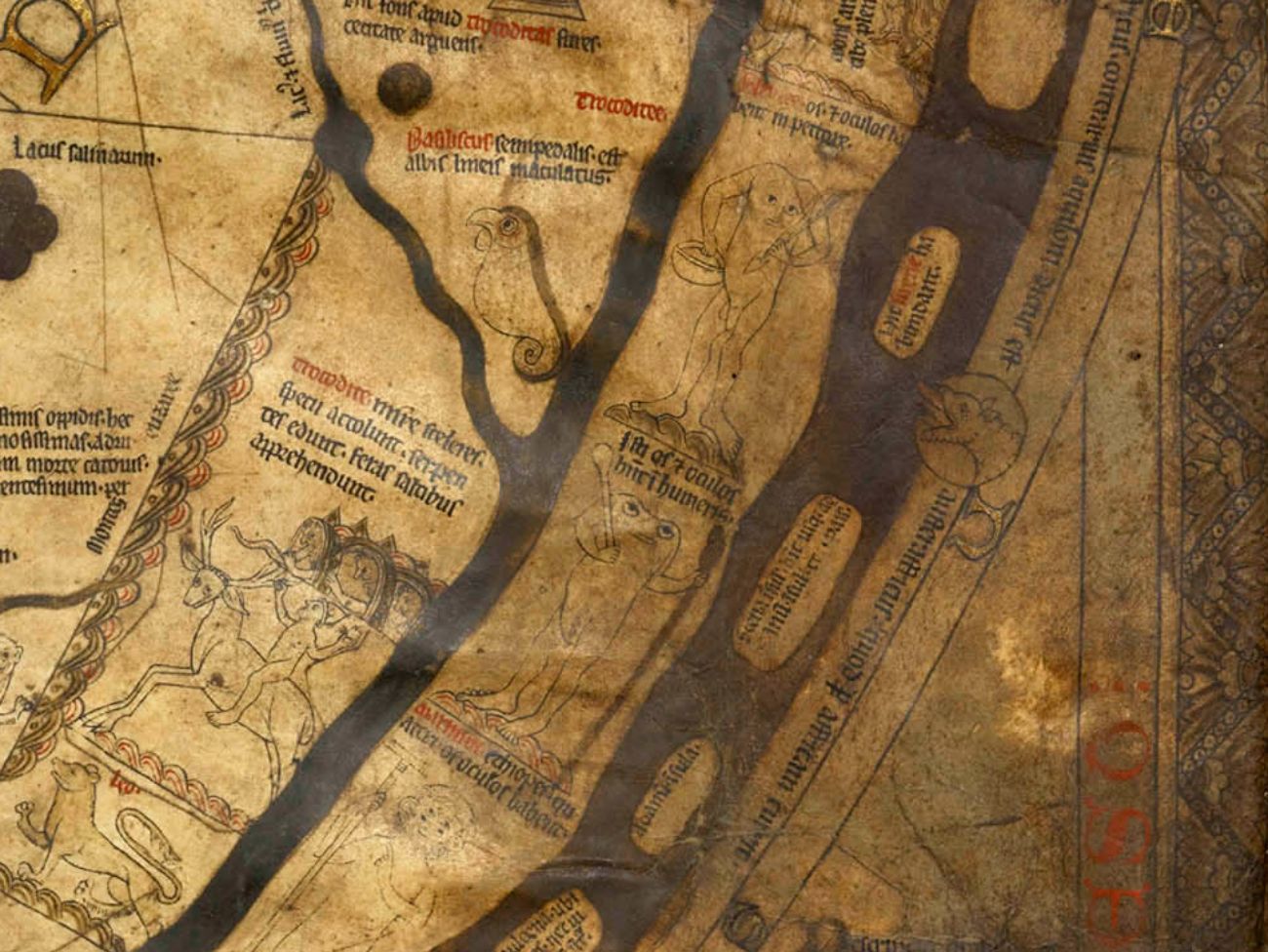
Hereford Mappa Mundi Blemmyes
During the Middle Ages, the Blemmyes appeared frequently on mappa mundi, historical maps blending geography with myth and lore. Cartographers of the time incorporated them alongside other fantastical beings like dragons and sea monsters, reflecting the belief in a world filled with wonders beyond the known. The Hereford Mappa Mundi, one of the most famous examples, includes the Blemmyes as a representation of the exotic and unknown.
While modern historians and anthropologists consider the Blemmyes a blend of misinterpreted cultural accounts and creative imagination, they remain an enduring symbol of humanity’s fascination with the mysterious.
The Headless Ewaipanomas in Historical Maps
The Ewaipanomas, another iteration of the mythical headless beings, gained fame through their depiction in early engravings, such as this 1599 map associated with Sir Walter Raleigh’s explorations of Guiana. These figures were described as people without heads, with their facial features situated on their chests. Raleigh himself referenced these beings in his accounts of South America, where he sought the legendary El Dorado.
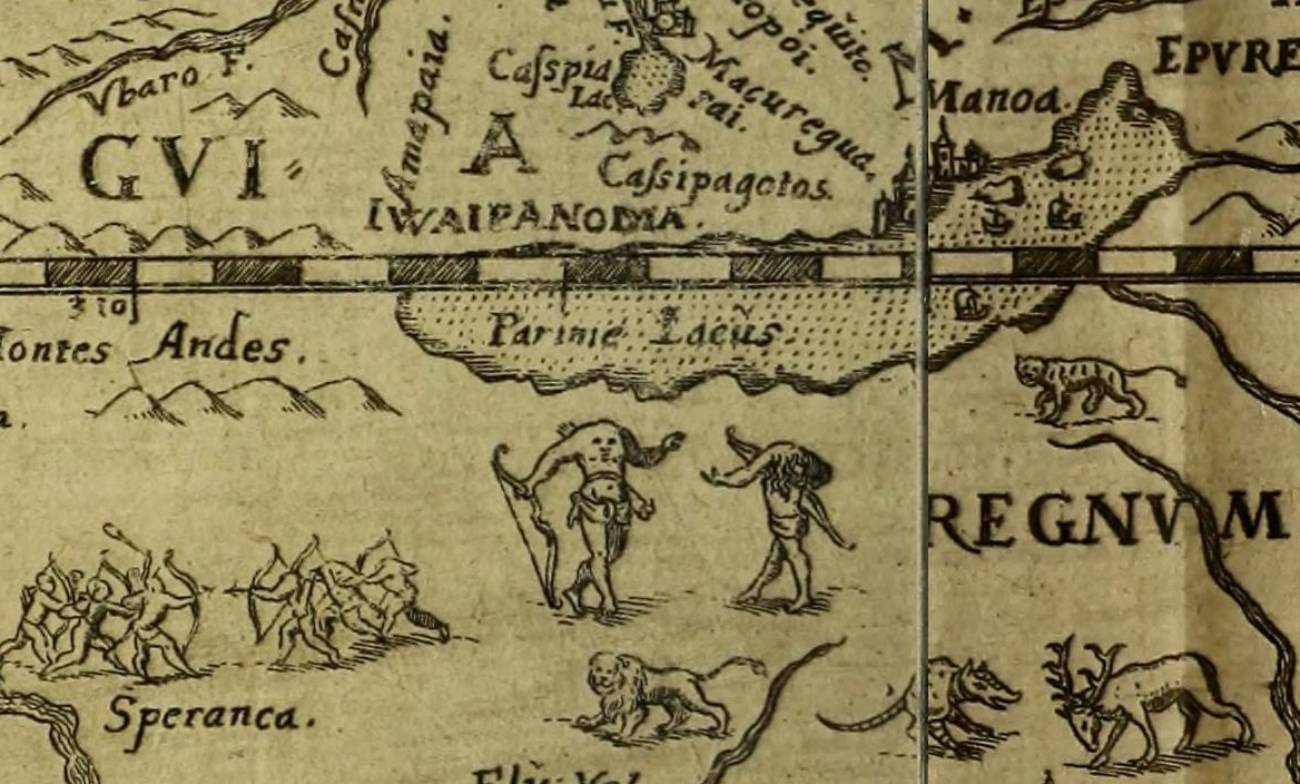
Headless Ewaipanomas (1599 engraving) – Wikipedia
In the engraving, the Ewaipanomas are shown with bows, quivers, and a distinct lack of traditional heads. This visual representation further immortalised them in European imagination as denizens of the unexplored and exotic New World. Maps of this period, including the one above, blended genuine geographic information with mythical elements, reflecting both the limited understanding of distant lands and the fascination with the unknown.
These depictions played a dual role, enhancing the allure of exploration while also reinforcing fantastical narratives about “otherworldly” peoples. Like the Blemmyes, the Ewaipanomas are now understood as mythical interpretations rather than factual descriptions, but they remain a captivating symbol of the era’s cartographic creativity and exploratory ambition.
Artistic Depictions of Myths
Ancient Art to Digital Creations
Throughout history, mythical creatures have captivated the human imagination, evolving in their artistic representations over millennia. These legendary beings, whether divine, fearsome, or heroic, have been central to cultural storytelling, inspiring artisans, painters, and digital creators alike. From ancient civilisations to the modern digital era, their depictions reflect not only the creativity of the times but also the values, beliefs, and technological advancements of each period.
- Ancient Pottery: Centaurs, griffins, and chimeras often adorned ancient pottery, where they symbolised divine or heroic interventions in human affairs. These figures were typically rendered in stylised forms, showcasing the technical skill of artisans from cultures such as Greece and Mesopotamia.
- Frescoes and Mosaics: Grand frescoes and intricate mosaics of antiquity, particularly in Roman and Byzantine contexts, elevated mythical beings to central roles in visual storytelling. These works frequently depicted gods battling monsters or interacting with mortals, reflecting societal values and religious beliefs.
- Modern Digital Art: Today, artists leverage digital tools to reinterpret mythical creatures. Films, video games, and graphic novels often reimagine griffins, dragons, and unicorns in hyper-realistic or surreal styles. These creations blend traditional motifs with cutting-edge technology to craft immersive worlds, pushing the boundaries of how these beings are perceived.
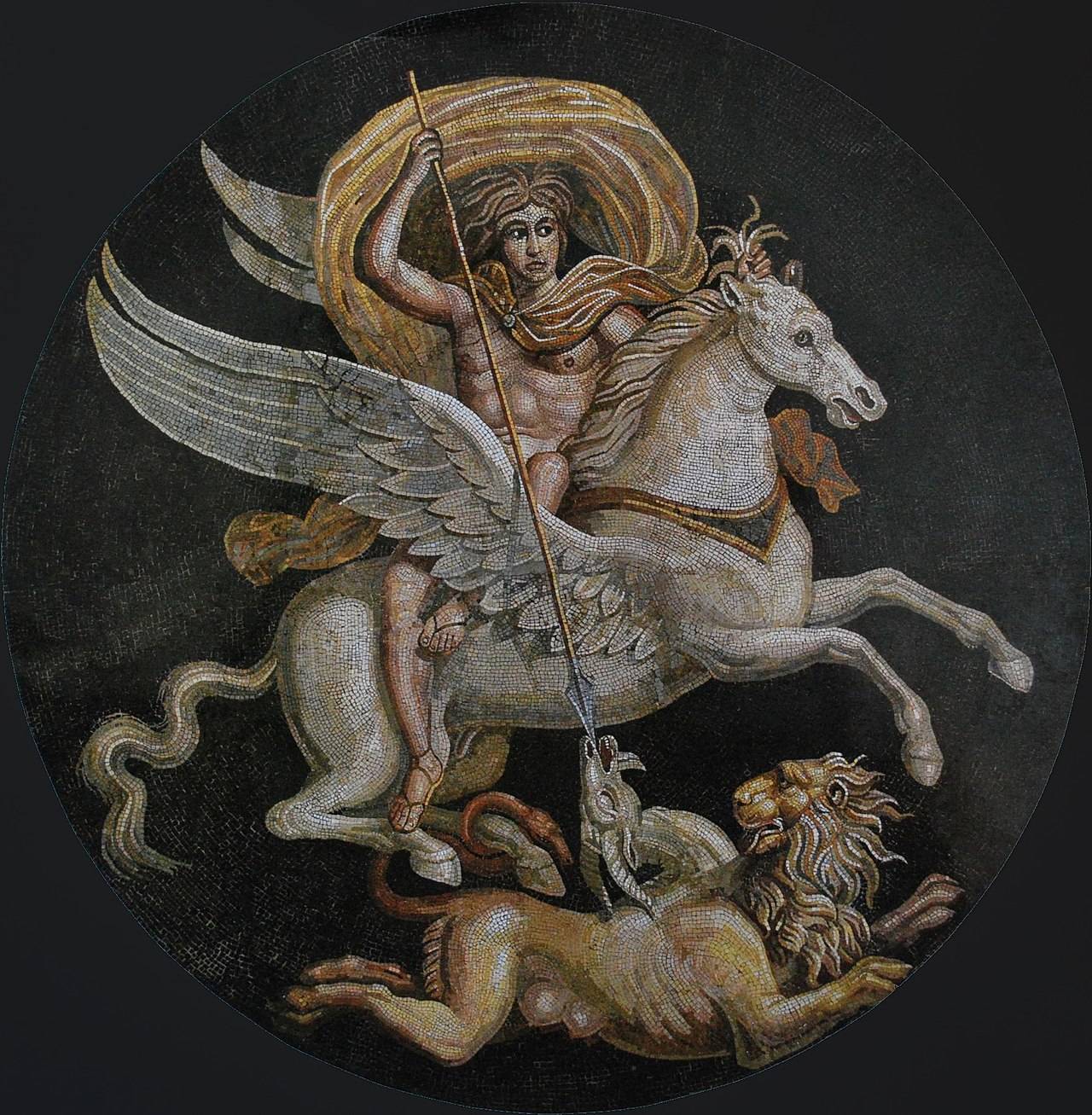
Bellerophon riding Pegasus and slaying the Chimera, Roman mosaic 2nd to 3rd century AD – Wikipedia
The evolution of mythical creatures across time and mediums highlights humanity’s enduring fascination with the mystical. By adapting these ancient legends to modern platforms, artists continue to explore timeless themes, proving that the allure of the fantastical transcends cultures and eras. With every new representation, mythical creatures bridge the gap between history and innovation, captivating audiences and keeping the magic alive for generations to come.
Illustrated Bestiaries and Manuscripts
Throughout the medieval era, bestiaries served as remarkable windows into the human imagination, blending knowledge, spirituality, and artistic innovation. These texts were far more than simple catalogues of creatures; they were deeply symbolic works that connected the natural and supernatural, offering moral lessons and theological insights. Bestiaries not only reflected the beliefs of their time but also inspired wonder and reverence through their stunning artistry.
- Definition & History: Bestiaries were compendiums that combined real and mythical creatures with moral and allegorical lessons. Their vibrant illustrations reflected an attempt to bridge the natural and supernatural worlds, often serving as a theological tool to explain divine order.
- Famous Manuscripts: Notable examples include the Aberdeen Bestiary and the Ashmole Bestiary. These texts feature exquisite depictions of creatures like unicorns, griffins, and manticores. The illuminated pages, enhanced with gold leaf and vibrant pigments, convey an unparalleled sense of wonder and devotion.
- Iconic Creatures:
- Lions: Representing strength and authority, lions were often depicted as guardians of faith and justice.
- Dragons: Frequently used as symbols of chaos or sin, dragons in bestiaries highlight the triumph of good over evil.
- Serpents: Representing both wisdom and temptation, serpents featured prominently as figures of duality.
- Cultural Parallels: While European bestiaries focused on Christian allegories, similar traditions existed globally. Islamic manuscripts incorporated mythical beings within scientific texts, blending faith with astronomy and medicine. In Chinese scrolls, dragons and phoenixes symbolised harmony and cosmic balance, underscoring shared themes of morality and universal order.

Griffin from Book of Flowers 1460 – getty.edu
The enduring legacy of medieval bestiaries lies in their ability to combine art, faith, and storytelling into a unified vision of the world. These texts not only served as educational tools but also as sources of inspiration, connecting cultures and eras through shared mythologies and values. Today, bestiaries remain a testament to the ingenuity of their creators, reminding us of humanity’s timeless desire to understand and interpret the mysteries of existence.
Sculptures and Architecture: Myths Cast in Stone
Architectural Application
Throughout history, architecture has served as a canvas for mythical creatures, blending functionality with storytelling. Cathedrals, palaces, and civic buildings incorporated gargoyles, chimeras, and griffins to convey both practical and symbolic purposes. Gargoyles functioned as water spouts, redirecting rainwater away from the structures, but their grotesque designs also evoked protective powers, warding off malevolent spirits. Meanwhile, griffins, hybrids of lions and eagles, adorned walls as emblems of strength and vigilance, guarding sacred and royal spaces. These architectural elements not only added visual drama but also reminded viewers of the supernatural forces believed to influence human existence.
The incorporation of mythical creatures was often a reflection of the cultural and spiritual priorities of the time. For example, Gothic cathedrals used their dramatic and imposing designs, including gargoyles, to inspire both awe and reverence, reinforcing the power and mystery of the divine. Civic buildings employed similar motifs, projecting power and stability while reinforcing their connection to the spiritual realm.
Regional Variations
The representation of mythical creatures in architecture varies widely across cultures, reflecting regional beliefs and artistic traditions:
- European Gothic Architecture: Gargoyles, with their exaggerated features and elongated forms, are iconic elements of Gothic cathedrals. They served as both functional and symbolic figures, evoking themes of protection and divine presence. The Notre Dame Cathedral in Paris is particularly renowned for its dramatic gargoyle carvings.
- East Asia: In contrast, East Asian architecture frequently highlights dragons and fu dogs. Dragons, associated with wisdom, prosperity, and protection, often appear on the roofs and gates of palaces and temples. Fu dogs, often placed in pairs, were seen as guardians warding off evil spirits, symbolising balance and harmony.
- Mayan and Aztec Structures: Feathered serpents like Quetzalcoatl are prominently featured in temples and pyramids. These creatures blend mythology with cosmology, representing the connection between the heavens and the earth. Their carvings often tell intricate stories of creation and divine intervention.
Other cultures similarly integrated mythical beings into their structures, emphasising the universal appeal of these figures in architecture. From Norse dragons carved into stave churches to Hindu temples adorned with apsaras (celestial dancers), these variations highlight the shared human tendency to use myths as a means of interpreting the world.
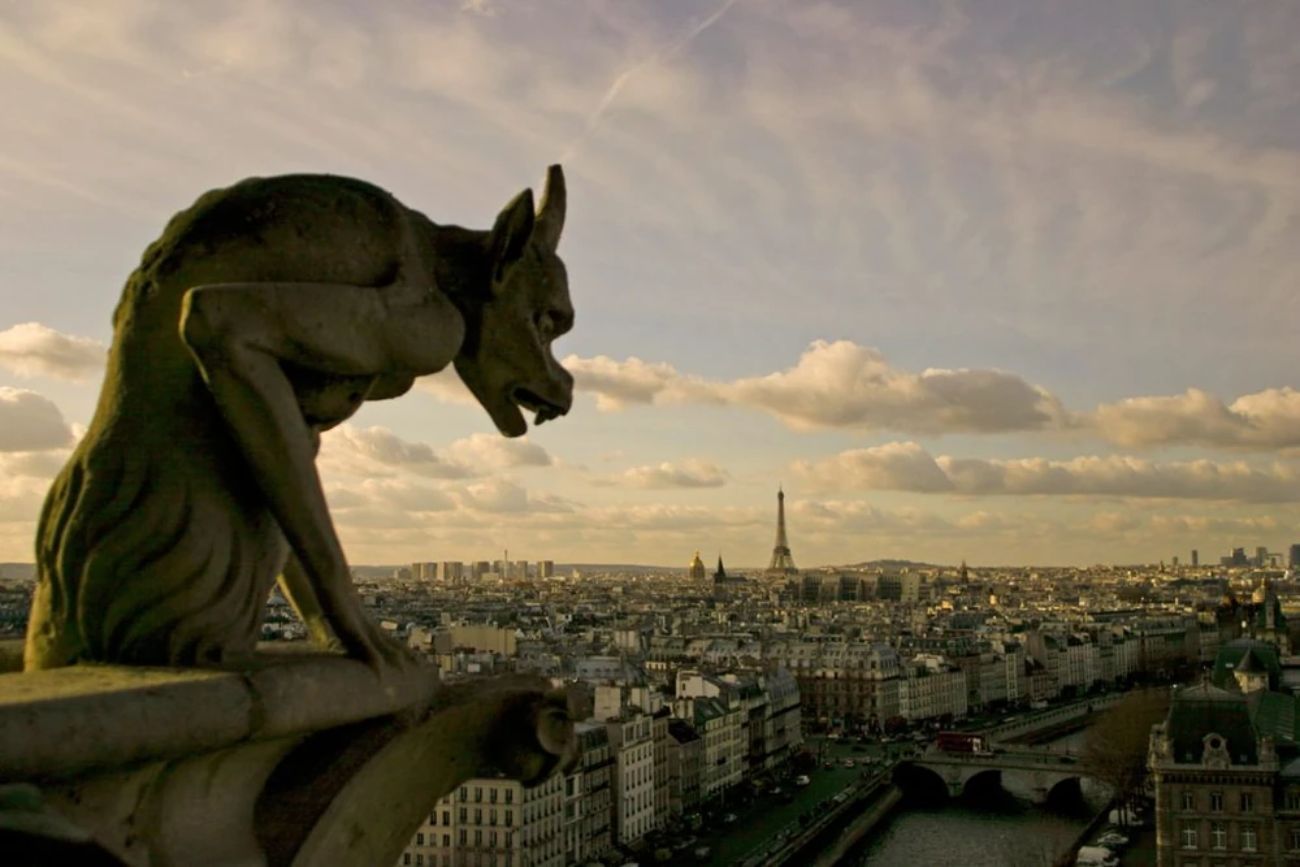
Gargoyle from the Notre-Dame – mythus.fandom
Symbolic Roles
The dual purposes of these sculptures, to protect and to inspire are central to their enduring significance. Gargoyles were believed to ward off evil spirits, serving as apotropaic symbols to safeguard buildings and their occupants. Meanwhile, dragons and other fantastical beings inspired awe with their intricate and dramatic designs, reminding viewers of the mysterious and divine forces that shaped their world.
The artistry of these sculptures reflects their cultural and spiritual importance. Gothic gargoyles feature highly detailed faces and postures, capturing expressions of terror, mischief, or watchfulness. East Asian dragons are often depicted with sinuous, flowing forms, emphasising grace and power. Similarly, the bold and intricate carvings of Mesoamerican feathered serpents reveal the profound cosmological significance these creatures held.
In bridging the functional and the fantastical, these sculptures continue to captivate modern viewers, offering a glimpse into the beliefs, values, and artistic achievements of past societies.
Ancient Texts and Legendary Creatures: Where Mythology Meets Documentation
Classical Sources
Throughout history, classical texts have shaped our understanding of mythical creatures and their profound impact on culture. Works like Homer’s Iliad and Ovid’s Metamorphoses laid the foundation for the artistic, literary, and philosophical traditions that followed, weaving tales of gods, mortals, and legendary beings into the fabric of human storytelling. These epic narratives not only entertained but also provided moral lessons and allegories for universal human experiences, exploring themes of power, transformation, and the delicate balance between fate and free will.
- Homer’s Creatures:
- The Cyclops: A one-eyed giant representing brute strength and primal power, famously encountered by Odysseus.
- Scylla: A multi-headed sea monster who, alongside Charybdis, posed an insurmountable challenge to sailors, symbolising inevitable dangers.
- Ovid’s Transformations:
- Daphne: Transformed into a laurel tree as a testament to purity and escape from Apollo’s pursuit.
- Arachne: Punished by the gods and turned into a spider, reflecting themes of hubris and divine retribution.
The enduring appeal of these stories lies in their ability to connect the human condition with the mythical. The vivid imagery and symbolic depth of these classical works continue to inspire interpretations across various mediums, from literature and art to theatre and film. By codifying mythical beings and their interactions with gods and mortals, texts like the Iliad and Metamorphoses have shaped how we view heroism, struggle, and the moral complexities of life.
These timeless tales serve as a bridge between ancient wisdom and modern creativity, proving that the stories of the past still resonate deeply within our collective imagination. From their allegorical meanings to their influence on artistic expression, they remind us of the power of mythology to transcend time and offer insight into our own experiences.
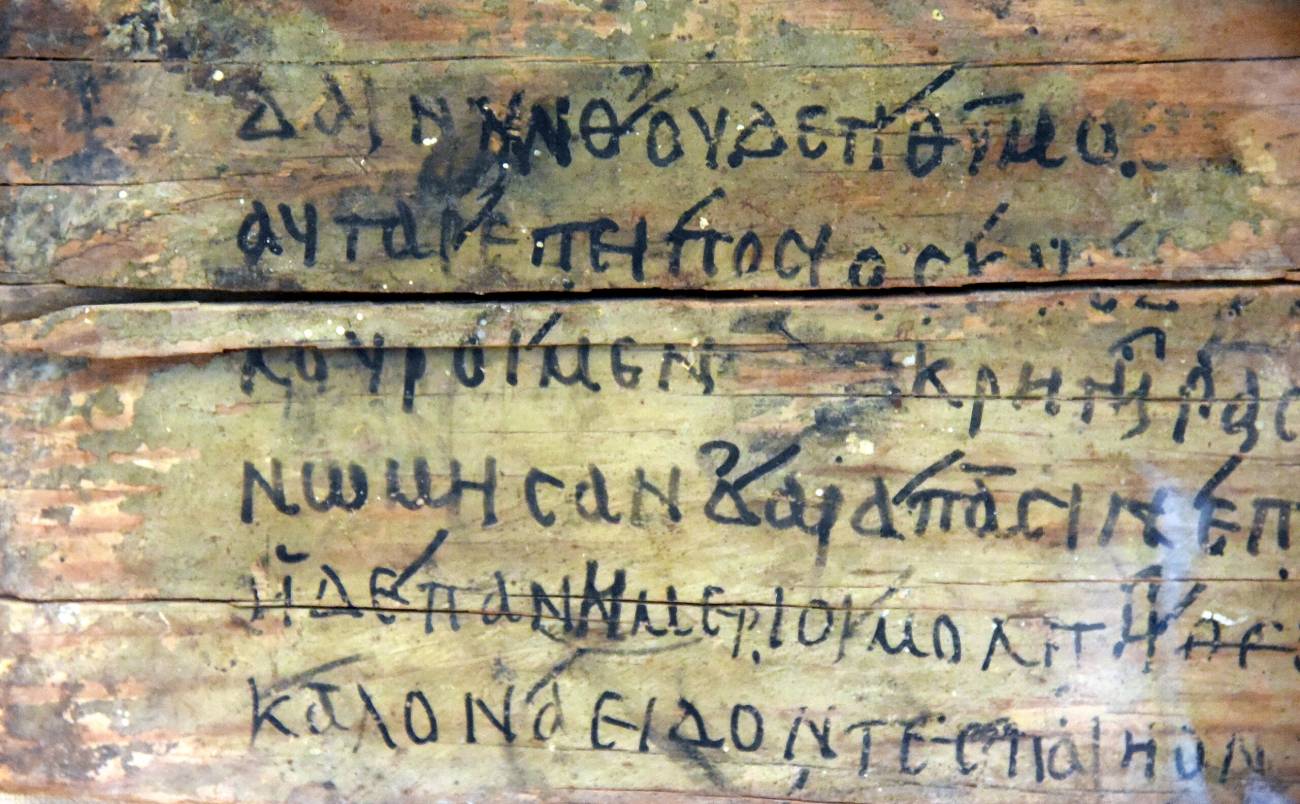
Inscription of lines 468–473, Book I. 400–500 AD, from Egypt. On display at the British Museum – Wikipedia
Religious or Philosophical Texts
Mythical creatures have long played a vital role in religious and philosophical traditions, serving as powerful symbols that convey universal values and cosmic principles. These beings often transcend their fantastical nature, becoming embodiments of spiritual ideals, moral lessons, and the mysteries of existence. Across diverse cultures, they are woven into sacred narratives and teachings, providing profound insights into humanity’s relationship with the divine, nature, and the universe itself.
Christian Iconography:
- Dragons: Often depicted as adversaries vanquished by saints, dragons symbolise the triumph of good over evil, with iconic examples like Saint George and the Dragon illustrating the eternal struggle between virtue and sin.
- Lambs: Representing innocence and sacrifice, lambs are prominently linked to Christ, symbolising redemption and purity.
Hindu Mythology:
- Shesha: The eternal cosmic serpent who supports Vishnu and signifies infinity, embodying the cyclical nature of creation and destruction.
- Garuda: A divine eagle, representing courage, devotion, and the victory of righteousness over darkness.
Buddhist Traditions:
- Nagas: Serpentine beings revered as protectors of natural elements like water and forests. They embody balance and harmony, illustrating the interconnectedness of all life.
Through these mythical figures, religious and philosophical systems provide a lens for understanding humanity’s place within the cosmos and the spiritual principles that govern existence. These creatures are not merely decorative elements in ancient texts or artwork but integral symbols that bridge the material and spiritual worlds, offering guidance and wisdom across generations.
The enduring legacy of mythical creatures in religious and philosophical traditions demonstrates their power to inspire reflection, provoke thought, and connect individuals to larger, transcendent truths. By exploring these timeless representations, we gain insight into the values and beliefs that have shaped cultures and continue to resonate with us today, reminding us of our shared quest for meaning and harmony in the universe.
Cultural Impact: The Ongoing Allure of Mythical Creatures
Symbolism & Reinvention
Dragons, for example, symbolise wisdom and power in Chinese culture, embodying prosperity, strength, and celestial harmony. In contrast, European traditions portray dragons as dangerous adversaries, often linked to chaos and evil in tales of heroic conquest. Modern interpretations adapt these creatures to diverse contexts, from epic fantasy literature, like Tolkien’s Smaug, to corporate branding, where dragons appear in logos to convey energy and resilience. These evolving depictions demonstrate the adaptability of mythical creatures in reflecting cultural values and aspirations over time.

“Conversation with Smaug” by J.R.R. Tolkien – tolkiengateway.net
Additionally, the phoenix, another globally recognised mythical figure, symbolises rebirth and immortality. Its interpretations span from the ancient Egyptian Bennu, a solar deity, to modern motivational metaphors of renewal in popular culture. The phoenix’s enduring appeal lies in its ability to inspire hope and perseverance.
Adaptations in Design
Modern media and industries frequently draw from the rich well of mythical imagery to captivate audiences and convey powerful messages:
- Video Games: Mythical creatures like griffins, dragons, and unicorns populate immersive gaming worlds, serving as both allies and foes. Games such as The Witcher and Skyrim integrate these beings to enhance storytelling and gameplay dynamics.
- Fashion and Jewellery: Designers often incorporate motifs of mythical creatures into accessories and clothing, blending tradition with innovation. For example, dragon-shaped pendants and phoenix-embroidered garments evoke strength and transformation.
- Corporate Logos: Businesses use mythical symbols to project traits like loyalty, endurance, and grandeur. Examples include luxury brands featuring unicorn emblems and sports teams adopting dragon mascots to signify power.
- Legendary Films: Renowned filmmaker Ray Harryhausen brought mythical creatures to life with groundbreaking stop-motion effects. Films like Clash of the Titans vividly portrayed beings such as Medusa, the Kraken, and Pegasus, setting a high standard for visual storytelling and fostering a renewed fascination with ancient myths.
By reimagining mythical creatures in contemporary settings, designers and creators breathe new life into ancient legends, weaving them seamlessly into the fabric of modern culture. This creative approach bridges the gap between the profound symbolism of the past and the cutting-edge innovation of today, ensuring these timeless figures remain relevant and inspiring. Whether through digital art, film, fashion, or interactive media, these reinterpretations allow mythical creatures to resonate with new audiences, highlighting their enduring appeal and versatility across diverse creative disciplines.
Flags and Coats of Arms: Mythical Identities in Heraldry
Heraldic Traditions
Mythical creatures have been integral to heraldry for centuries, symbolising power, prestige, and protection. These emblems served as visual representations of familial, regional, or national identity, conveying authority, mystique, and a connection to ancient traditions. By incorporating mythical figures, heraldry reflected the values and aspirations of the time, while showcasing societal hierarchies and cultural pride.
Iconic Examples
- Welsh Dragon: Rooted in Celtic mythology, the red dragon is a symbol of pride, resilience, and defiance. Featured prominently on the Welsh flag, it embodies both its legendary role in Arthurian tales and its protective association with Wales.
- Unicorn in the UK Royal Arms: Representing purity, nobility, and controlled power, the unicorn is paired with the lion in the UK’s royal arms to symbolise unity and strength.
- Double-Headed Eagle: Used in Byzantine, Russian, and Austro-Hungarian heraldry, this symbol conveys dual authority over spiritual and temporal realms, reflecting the vast influence of these empires.
- Griffin: A popular choice in English and European coats of arms, the griffin symbolises courage, vigilance, and guardianship, often evoking strength and prestige.
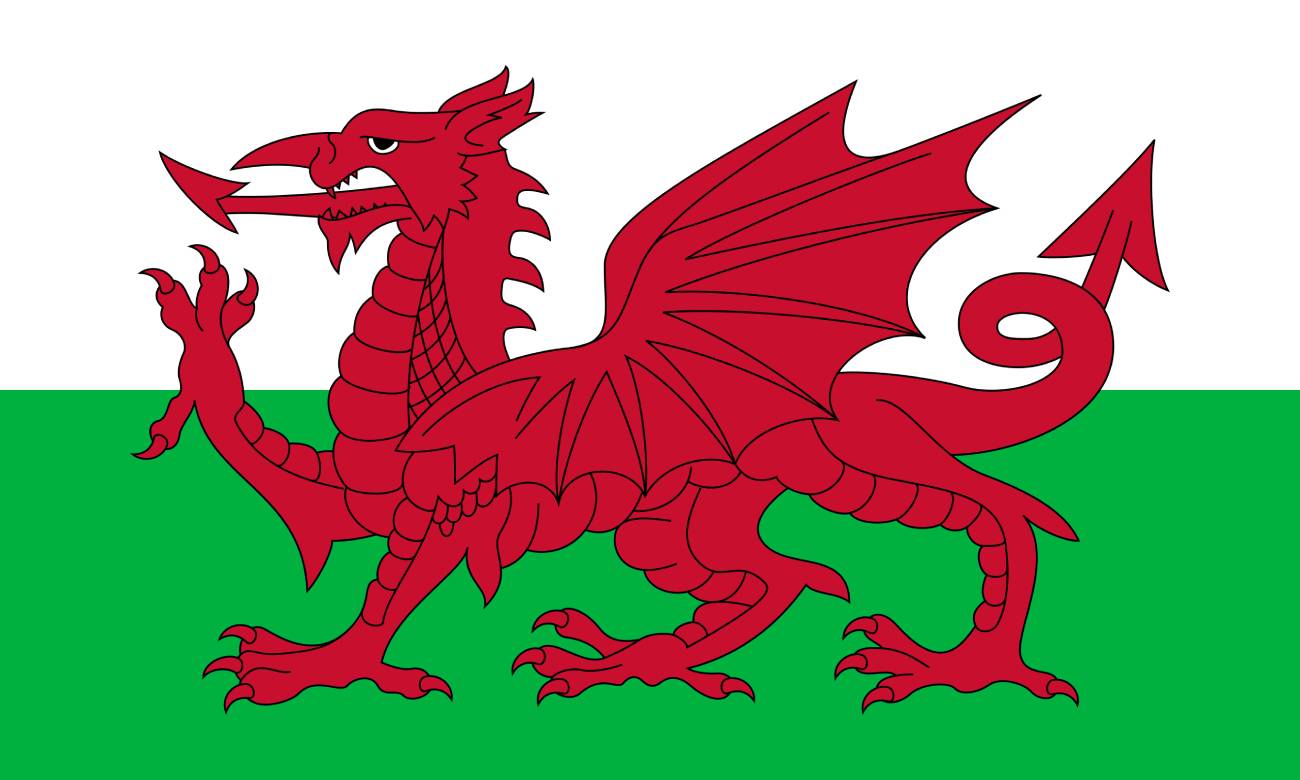
Flag of Wales
Design Evolution
Heraldic art has evolved over centuries, adapting to modern aesthetics while preserving its symbolic essence. In medieval times, intricate hand-painted shields and banners showcased mythical creatures in vibrant detail, often accompanied by mottos to amplify their meaning.
In the modern era, these motifs have been reimagined in flags, logos, and branding. For example:
- National Symbols: The Welsh dragon remains a defining emblem of Welsh heritage, prominently displayed on the national flag.
- Contemporary Branding: Companies and sports teams incorporate heraldic elements, such as Ferrari’s prancing horse or the Welsh Rugby Union’s red dragon, blending historical symbolism with modern identity.
The enduring use of mythical creatures in heraldry highlights their timeless appeal and symbolic power. Whether on medieval shields or modern logos, these figures continue to inspire, connecting ancient traditions with contemporary design and identity.
Bringing It All Together: Lessons, Legacy, and Exploration
Mythical creatures have profoundly shaped humanity’s cultural and artistic heritage, serving as enduring symbols of imagination, identity, and universal themes. From the illuminated pages of medieval bestiaries to their presence in national flags, sculptures, and architectural details, these legendary beings embody values such as courage, transformation, and the triumph of good over evil. Through their depictions in art, design, and storytelling, they continue to connect us to our shared past and inspire modern interpretations.
The global exchange of mythical imagery, from trade routes like the Silk Road to Renaissance artistic dialogues, reveals the interconnectedness of cultural traditions. Creatures like dragons, phoenixes, and griffins transcend borders, illustrating humanity’s fascination with the unknown and its ability to find common meaning in diverse symbols. Their symbolic potency has evolved alongside societies, blending ancient wisdom with contemporary innovation in films, video games, and modern design.
Key Takeaways:
- Artistic Techniques: Mythical creatures inspired artistic innovations, from the intricate illuminations of manuscripts to the dramatic carvings of Gothic cathedrals.
- Cultural Exchange: Shared imagery, such as dragons appearing in both Eastern and Western traditions, highlights the universality of myth.
- Timeless Mysteries: Creatures like the phoenix and leviathan capture humanity’s curiosity about the natural and cosmic worlds.
- Modern Resonance: Today, mythical figures influence art, design, and media, showcasing their lasting relevance and adaptability.
Exploration and Inspiration
To uncover the legacy of mythical creatures, explore historical texts, visit iconic landmarks, or delve into modern adaptations in media and design. Resources like the British Library’s digitised collections, local monuments, or classics like The Iliad and Metamorphoses provide rich insights into these timeless legends.
Embark on your own journey to discover the mythical figures hidden in art, architecture, and literature. Let their stories inspire your creativity and deepen your connection to the universal themes that define human culture. Whether through ancient manuscripts or digital media, mythical creatures remind us of the enduring power of storytelling and the boundless potential of human imagination.
Further Research Points
- https://www.reddit.com/r/mythology/
- https://www.youtube.com/@Restitutor_Orbis_214
- https://www.youtube.com/@MrMythos
- https://www.mandelasfavoritefolktales.com/
- https://www.beatricepublicschools.org/pages/uploaded_files/Mythological%20Creatures.pdf
- https://www.themappamundi.co.uk/mappa-mundi/
- https://www.davidrumsey.com/blog/2017/11/26/largest-early-world-map-monte-s-10-ft-planisphere-of-1587




